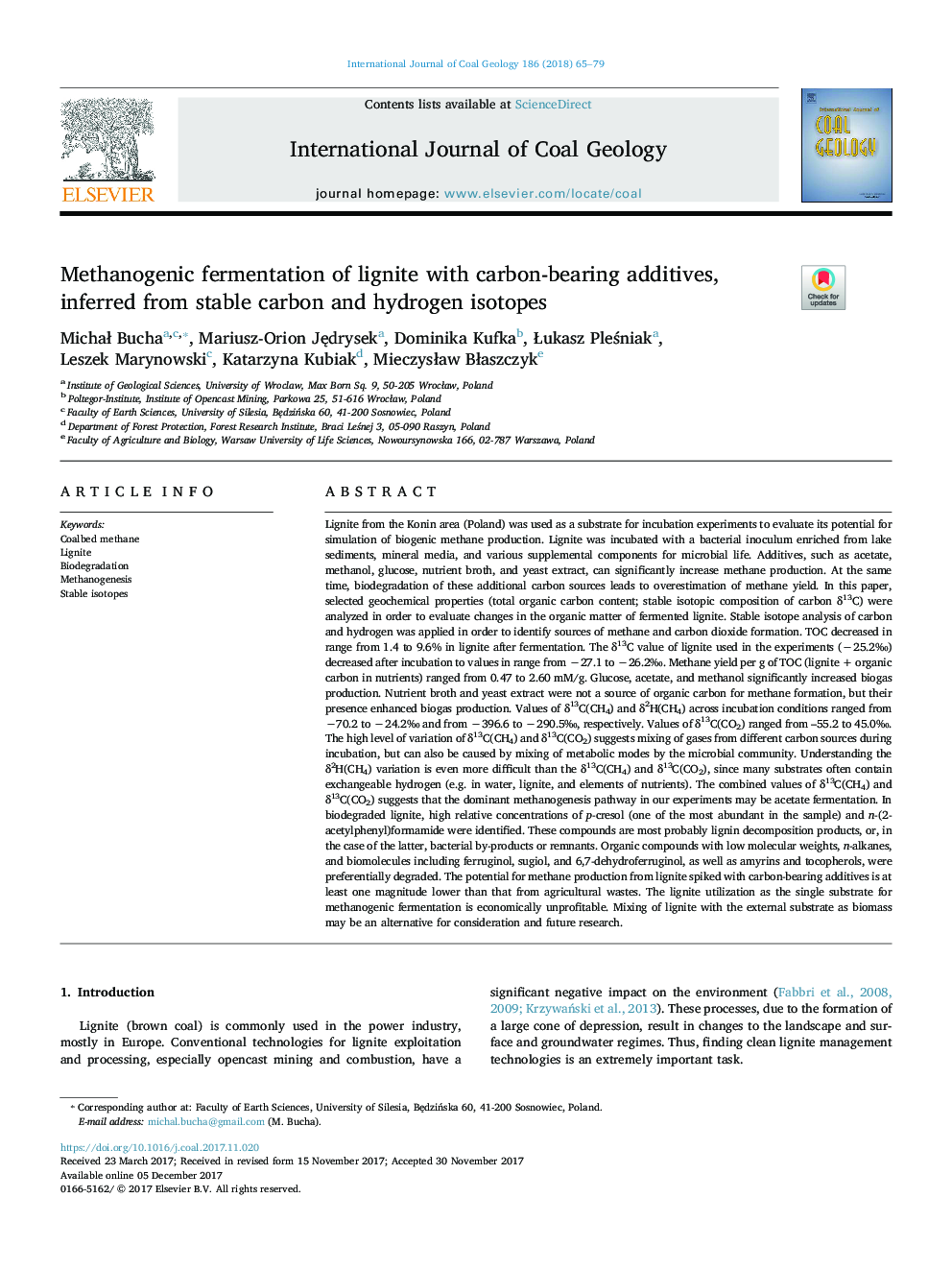| کد مقاله | کد نشریه | سال انتشار | مقاله انگلیسی | نسخه تمام متن |
|---|---|---|---|---|
| 8123592 | 1522517 | 2018 | 15 صفحه PDF | دانلود رایگان |
عنوان انگلیسی مقاله ISI
Methanogenic fermentation of lignite with carbon-bearing additives, inferred from stable carbon and hydrogen isotopes
ترجمه فارسی عنوان
تخمیر متانوژن لیگنیت با افزودنی های کربنی، که از ایزوتوپ کربن و ایزوتوپ هیدروژن پایدار است
دانلود مقاله + سفارش ترجمه
دانلود مقاله ISI انگلیسی
رایگان برای ایرانیان
کلمات کلیدی
موضوعات مرتبط
مهندسی و علوم پایه
علوم زمین و سیارات
زمین شناسی اقتصادی
چکیده انگلیسی
Lignite from the Konin area (Poland) was used as a substrate for incubation experiments to evaluate its potential for simulation of biogenic methane production. Lignite was incubated with a bacterial inoculum enriched from lake sediments, mineral media, and various supplemental components for microbial life. Additives, such as acetate, methanol, glucose, nutrient broth, and yeast extract, can significantly increase methane production. At the same time, biodegradation of these additional carbon sources leads to overestimation of methane yield. In this paper, selected geochemical properties (total organic carbon content; stable isotopic composition of carbon δ13C) were analyzed in order to evaluate changes in the organic matter of fermented lignite. Stable isotope analysis of carbon and hydrogen was applied in order to identify sources of methane and carbon dioxide formation. TOC decreased in range from 1.4 to 9.6% in lignite after fermentation. The δ13C value of lignite used in the experiments (â25.2â°) decreased after incubation to values in range from â27.1 to â26.2â°. Methane yield per g of TOC (lignite + organic carbon in nutrients) ranged from 0.47 to 2.60 mM/g. Glucose, acetate, and methanol significantly increased biogas production. Nutrient broth and yeast extract were not a source of organic carbon for methane formation, but their presence enhanced biogas production. Values of δ13C(CH4) and δ2H(CH4) across incubation conditions ranged from â70.2 to â24.2â° and from â396.6 to â290.5â°, respectively. Values of δ13C(CO2) ranged from -55.2 to 45.0â°. The high level of variation of δ13C(CH4) and δ13C(CO2) suggests mixing of gases from different carbon sources during incubation, but can also be caused by mixing of metabolic modes by the microbial community. Understanding the δ2H(CH4) variation is even more difficult than the δ13C(CH4) and δ13C(CO2), since many substrates often contain exchangeable hydrogen (e.g. in water, lignite, and elements of nutrients). The combined values of δ13C(CH4) and δ13C(CO2) suggests that the dominant methanogenesis pathway in our experiments may be acetate fermentation. In biodegraded lignite, high relative concentrations of p-cresol (one of the most abundant in the sample) and n-(2-acetylphenyl)formamide were identified. These compounds are most probably lignin decomposition products, or, in the case of the latter, bacterial by-products or remnants. Organic compounds with low molecular weights, n-alkanes, and biomolecules including ferruginol, sugiol, and 6,7-dehydroferruginol, as well as amyrins and tocopherols, were preferentially degraded. The potential for methane production from lignite spiked with carbon-bearing additives is at least one magnitude lower than that from agricultural wastes. The lignite utilization as the single substrate for methanogenic fermentation is economically unprofitable. Mixing of lignite with the external substrate as biomass may be an alternative for consideration and future research.
ناشر
Database: Elsevier - ScienceDirect (ساینس دایرکت)
Journal: International Journal of Coal Geology - Volume 186, 1 February 2018, Pages 65-79
Journal: International Journal of Coal Geology - Volume 186, 1 February 2018, Pages 65-79
نویسندگان
MichaÅ Bucha, Mariusz-Orion JÄdrysek, Dominika Kufka, Åukasz PleÅniak, Leszek Marynowski, Katarzyna Kubiak, MieczysÅaw BÅaszczyk,
